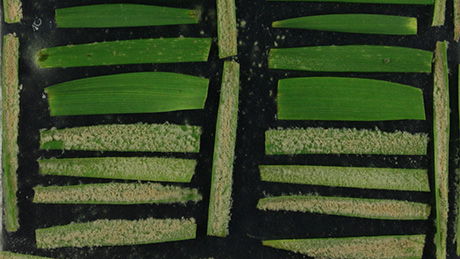Navigation auf uzh.ch
Navigation auf uzh.ch

Triticale is an artificial grain type stemming from a cross between wheat and rye. Since the 1960s, triticale has been cultivated in many places as a feed grain and had proved very resistant to mildew attack. This fungal pathogen causes huge losses in cereal production. In the case of wheat, for example, the fungus can reduce the harvest by up to 45%. But triticale fields were infected for the first time in 2001, and mildew is now being reported in many triticale growing regions in Europe.
Researchers from the University of Zurich have now examined how the mildew managed to spread to triticale. To do this, they collected samples from infected grain fields all over Europe and examined the genetic information of different forms of mildew. The genetic material (genome) of the pathogens that attack triticale, rye and wheat were then compared using bioinformatics. The comparisons showed that the new triticale fungus is a hybrid of the variants specialized in wheat and rye: 12.5% of the genome is identical to DNA sequences from the form specialized in rye, while 87.5% stems from the form specialized in wheat.
This means
that a hybrid from two mildew variants specialized in two different host plants
can infect the cross between those two host plants. The study thus shows the
manner in which mildew adapts to new host plants in a co-evolutionary way and
can break down their resistance. The study also reveals that this recent
evolutionary event was not a one-off occurrence. Around 10,000 years ago,
mildew overcame the resistance of bread wheat, which was relatively new at the time,
in the same way. “These results are of major significance for treating and
preventing plant diseases. The more we know about the evolutionary mechanisms
of mildew, the better we can keep new cultivated plants resistant to the
pathogens”, explains Thomas Wicker from the Institute of Plant Biology at the
University of Zurich.
Literature
:
Fabrizio Menardo, Coraline R Praz, Stefan Wyder, Roi
Ben-David, Salim Bourras, Hiromi Matsumae, Kaitlin E McNally, Francis Parlange,
Andrea Riba, Stefan Roffler, Luisa K Schaefer, Kentaro K Shimizu, Luca Valenti,
Helen Zbinden, Thomas Wicker& Beat Keller. Hybridization of
powdery mildew strains gives raise to pathogens on novel agricultural crop
species. Nature Genetics, 11 January 2016. Doi: 10.1038/ng.3485.